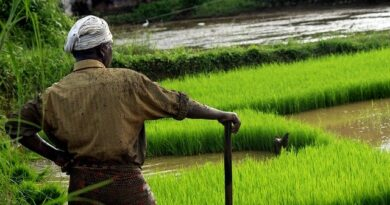Pradhan Mantri Sahaj Bijli Har Ghar Yojana -“Saubhagya”
Ministry of Power
Context:
About Saubhagya:
- Pradhan Mantri Sahaj Bijli Har Ghar Yojana – ‘Saubhagya’ scheme was launched by the Hon’ble Prime Minister on 25th September, 2017.
- Under Saubhagya free electricity connections to all households (both APL and poor families) in rural areas and poor families in urban areas will be provided.
- There are around 4 Crore un-electrified households in the country and they are targeted for providing electricity connections by December 2018. Rural Electrification Corporation (REC) has been designated as nodal agency for the Saubhagya scheme.
- To expedite and monitor the electrification process under Saubhagya a web portal was launched by Minister of State (IC) for Power and New & Renewable Energy on 16th November 2017. The Saubhagya web portal has been designed and developed to disseminate information about the village wise Household Electrification Status across the country.
- Under the Saubhagya scheme, DISCOMs will organize camps in villages/cluster of villages to facilitate on-the-spot filling up of application forms including release of electricity connections to households. DISCOMs/Power Departments will also adopt innovative mechanisms like dedicated web-portal/Mobile App for collection/consolidation of application form in electronic mode and also capturing process of release of electricity connections. The details of consumers like Name, Address and Identification proof as available (Aadhar number/Mobile number/Bank account/Driving License/Voter ID etc.) would be collected by the DISCOMs.
Scope of the Scheme:
- Providing last mile connectivity and electricity connections to all un-electrified households in rural areas.
- Providing Solar Photovoltaic (SPV) based standalone system for un-electrified households located in remote and inaccessible villages / habitations, where grid extension is not feasible or cost effective.
- Providing last mile connectivity and electricity connections to all remaining economically poor un-electrified households in urban areas. Non-poor urban households are excluded from this scheme.
Salient Features of Saubhagya are:
- The prospective beneficiary households for free electricity connections under the scheme would be identified using SECC 2011 data. However, un-electrified households not covered under SECC data would also be provided electricity connections under the scheme on payment of Rs. 500 which shall be recovered by DISCOMs in 10 instalments through electricity bill.
- The electricity connections to un-electrified households include provision of service line cable, energy meter including pre-paid/smart meter, single point wiring. LED lamps and associated accessories in line with technical specifications and construction standard.
- In case of un-electrified households located in remote and inaccessible areas, power packs of 200 to 300 Wp(with battery bank) with a maximum of 5 LED lights, 1 DC Fan, 1 DC power plug etc. may be provided along with provision of Repair and Maintenance (R&M) for 5 years.
- All DISCOMs including Private Sector DISCOMs, State Power Departments and RE Cooperative Societies shall be eligible for financial assistance under the scheme in line with DDUGJY.
- Some of the eligible entities are yet to provide free connections to BPL households already sanctioned under DDUGJY. In case such entities are not able to find the adequate number of BPL households in the project area, such number of households shall not be considered for funding of service connection cost under Saubhagya to avoid any possibility of duplication.
- The details of consumers viz, Name and Aadhar number/ Mobile number/ Bank account/ Driving License/Voter ID etc., as available would be collected by the DISCOMs.
- The defaulters whose connections have been disconnected should not be given benefit of the scheme. However, the utilities may consider settlement of old dues and reconnection as per norms.
Objectives Saubhagya
The scheme aims to fulfil the following goals and objectives:
- Reduced environmental degradation by ruling out the use of Kerosene for lighting purposes.
- Improved educational services.
- Improved health services.
- Improvement in communication.
- Improvement in public safety and quality of life, primarily for women.
- Increased employment opportunities.
- Increased economic activity.
Condition of Power Sector in India
- The Ministry of Power which started functioning independently in 1992 is primarily responsible for the development of electrical energy in the country.
- India ranks third globally in terms of electricity production.
- As per the Paris Accord on Climate Change, India made a pledge that by 2030, 40% of installed power generation capacity shall be based on clean sources, it was determined that 175 GW of renewable energy capacity will be installed by 2022.
- This includes 100 GW from solar, 60 GW from wind, 10 GW from bio-power and 5 GW from small hydropower.
- India has 5th Global position for overall installed renewable energy capacity, 4th position for wind power and 5th position for solar power.
- As of October, 2018, a total of around 73.35 GW of renewable energy capacity has been installed in the country, which includes around 34.98 GW from Wind, 24.33 GW from solar, 4.5 GW from Small Hydro Power and 9.54 GW from Bio-power.
- Power sector has a 100% foreign direct investment (FDI) permit, which boosted FDI inflows in the sector.
What are the expected outcomes of the Saubhagya Scheme?
The government specified expected outcomes of the Saubhagya scheme are:
- Access to all willing households
- Environmental upgradation by substitution of Kerosene for lighting purposes
- Improvement education services
- Better health services
- Enhanced connectivity through radio, television, mobiles, etc.
- Increased economic activities and jobs
- Improved quality of life especially for women
Other Initiatives
- Deendayal Upadhyaya Gram Jyoti Yojana (DDUGJY): The rural electrification scheme provides for (a) separation of agriculture and non-agriculture feeders; (b) strengthening and augmentation of sub-transmission and distribution infrastructure in rural areas including metering at distribution transformers, feeders and consumers end.
- Integrated Power Development Scheme (IPDS): The scheme provides for (a) strengthening of sub-transmission and distribution networks in urban areas; (b) metering of distribution transformers/feeders/consumers in urban areas; and (c) IT enablement of distribution sector and strengthening of distribution network.
- Ujwal Discom Assurance Yojana (UDAY): The scheme has been launched for operational and financial turnaround of Discoms.
- ‘4 Es’ in the revised Tariff Policy: The 4Es include Electricity for all, Efficiency to ensure affordable tariffs, Environment for a sustainable future, Ease of doing business to attract investments and ensure financial viability.
- GARV (Grameen Vidyutikaran) App: To monitor transparency in implementation of the electrification schemes, Grameen Vidyut Abhiyantas (GVAs) have been appointed by the government to report progress through GARV app.
Source: PIB
You can find many articles on ENERGY (part of GS III) in our website. Go through these articles share with your friends and post your views in comment section.



